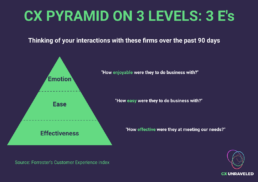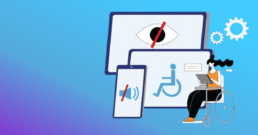Energizer: the secret triangle
"The secret triangle" is an energizer or team-building activity designed to promote team bonding and encourage participants to work together.
Objective: The goal of this activity is to foster better team cohesion and make participants think strategically and cooperate without revealing their choices. Minimum group size: 6
Instructions:
- Scattered Participants: Initially, have all the participants spread out or scatter themselves around the room. This is to ensure they are not close to each other when they start the activity.
- Select Two People: Each participant is instructed to choose two people from the group in their mind without revealing their choices to anyone else. This is the secret part of the activity.
- Create an Imaginary Triangle: As everyone continues to move around, participants are asked to position themselves in a way that creates an imaginary triangle using the people they've chosen in step 2. This means they need to strategically move so that the two people they've selected become the three points of a triangle with themselves as the third point. It's important that they do this without discussing their choices with others or revealing who they've picked.
- Surprising Outcome: The fun part of the activity is letting the participants create the triangle and then observing the result. This activity often leads to unexpected arrangements and interactions as people try to form the desired triangle while avoiding revealing their choices to others.
- Evaluate: After participants have successfully formed their imaginary triangles without revealing their choices to others, it's time to gather the group and reflect on the activity. This step is essential for the participants to discuss and learn from the experience. Here's how it can be done:
- Guess Who The Two People Were: Ask each participant to reveal the two people they had in mind when forming their imaginary triangle. This step is crucial because it allows participants to see if others correctly guessed the people they chose. It can be surprising to find out if others guessed correctly or not.
- Share Experiences: Encourage participants to share their experiences during the activity. Did they find it challenging to position themselves without revealing their choices? What strategies did they use to create the desired triangle? Were there any surprises or unexpected interactions? This discussion helps participants understand the dynamics of the group and how different strategies were employed.
- Discuss Strategies: Encourage participants to explain the strategies they used to position themselves in the triangle. Some participants may have opted to stand still, while others might have decided to move strategically to achieve their goal. Discussing these strategies can lead to insights into how people approach problem-solving and cooperation.
Purpose: This energizer encourages participants to work together non-verbally to achieve a common goal. It promotes team bonding, trust, and collaboration as participants need to carefully analyze the group dynamics and strategically position themselves without direct communication. The surprise element adds an element of fun and challenge to the activity.
Energizer: postcard
Objective: The goal of this activity is to establish creative confidence, encourage effortless collaboration, and build the capacity for working together as a workshop group. Minimum group size: 2
Materials:
- Markers (1 per participant)
- Paper, preferably in postcard-sized sheets
Steps:
- Preparation: Participants can sit around a table or in a circle, but this arrangement is not mandatory. Hand out a sheet of paper or a postcard and a pen (marker) to each participant. Ensure that all pens are identical in color and size, not too thick nor too thin, as this consistency tends to yield better results.
- Invitation: Announce to the group that you'll be creating something together in the next few minutes. Let them know you'll guide them through a series of simple tasks, and it's important to follow instructions precisely, especially in the last two steps.
- Instructions for the Group:
- Draw a Form: Each participant starts by drawing a random form on their paper. Once they've completed their drawing, they pass their paper to the person on their left or right. Stick to one direction consistently (left or right).
- Create Something: The next participant, using the form they received from their neighbor, turns it into an object, person, or animal. Then, they pass the paper on.
- Add Context: The next participant adds a context or setting to the drawing they've received from their neighbor and passes it on.
- Add Action or Drama: The subsequent participant adds an action or some drama to the drawing. Emphasize that they should refrain from using text at this stage. After this, they pass on the paper.
- Add Text: The final participant adds text to the drawing, which completes the postcard. You can encourage them to be creative with their text.
Additional Idea: After becoming familiar with the activity, you can introduce some variation:
- Themed Doodling: Play a certain style of music during the creative process. For example, using Christmas songs may lead to interesting holiday-themed postcards.
This activity is a creative and collaborative exercise that encourages participants to think outside the box and fosters creative confidence while emphasizing the value of working together as a team.
Energizer: up, down, left, right
Up, down, right, left
Objective: The goal of this activity is to help participants experience the challenges of unlearning previous associations, emphasizing the need to unlearn to learn something new. Minimum group size: 2
Instructions:
- Brief the Participants: Ask all participants to stand up. Let them know that they will be given instructions on which direction to look, and they should respond by tilting their heads in the indicated direction. Emphasize that only the head should move, not the entire body.
- Explain the Details: Provide clarity on how to respond to the instructions. When you say "Up," participants should tilt their heads to look at the ceiling or sky. When you say "Down," they should lower their heads to look at the floor or their feet. "Left" and "Right" require participants to turn their heads accordingly.
- Give Directions: Start giving instructions using the words "up," "down," "left," and "right" in a random order. Encourage participants to follow your directions, keeping the pace fairly rapid.
- Change the Meaning: After about a minute of following the initial instructions, inform the participants that you are going to make a change. Explain that from now on, "up" will mean "down" and vice versa. So, when you say "Down," they should actually look up at the ceiling, and when you say "Up," they should look down at their feet. Make it clear that "left" and "right" will remain the same. Continue to call out the four directions in a random order and ask the participants to follow the new instructions. Expect many "mistakes" and laughter.
- Conclude the Session: After another minute or so, announce the end of the activity.
Learning Points:
- Unlearning is a Challenge: This activity illustrates that unlearning old concepts is not easy and can be confusing. It demonstrates that you need to let go of previous knowledge or habits to adapt to new procedures or ways of doing things.
- Interference of Old Ways: The old way of doing things can interfere with learning new procedures. Participants experience firsthand how their pre-existing associations and habits can affect their ability to adapt to new instructions.
This activity is a fun and engaging way to highlight the cognitive challenges associated with unlearning and adapting to new information or processes. It promotes self-awareness and underscores the importance of being open to change and receptive to new learning.
Suitsupply's Three E's: Effectiveness, Ease, and Enjoyment in CX
Last week Peter had to buy a suit for a wedding on Thursday. And I am not sure about you, but Peter could definitely think of nicer things to do during his weekend!
But his visit to Suitsupply turned out to be a great experience that is worth sharing! What made it so great: let us explain this with the help of the Customer Need Pyramid. This model is being used by Forrester and it works with the 3E’s: Effectiveness, Ease, Emotion!
EFFECTIVE:
Peter was ‘on a mission’ to get his suit. His job to be done was to meet the strict dresscode and to look great for the wedding. And he succeeded! With fairly priced suits and the many choices that Suitsupply offers, he was not really in doubt about this one actually!
EASY:
What made it good was that the experience was completely effortless! Your name is registered the moment you walk in and a few minutes later a sales person comes to pick you up in the comfortable coffee corner. This person is your personal assistant that gives you full attention and won’t help any other customers till you have left the shop. You just have to give a short description what you are looking for and they will do all the work!
ENJOYABLE:
This is the best part: the one that makes you want to come back and share your experience with others. While waiting for help Peter could relax in the coffee area enjoying a nice cappuccino. The sales rep Lola (originally from Spain) was super friendly, gave good advice on shoes and shirts for the wedding (without pushing for additional sales). And while trying out various suits and talking about skiing, she gave some advice on a cool skiing area in Spain. And what really was a WOW-moment: as he needed to have his suit adjusted, Peter could pick it up on Wednesday. OK that’s a bit less effortless, but Lola told Peter that this was her day off and she would be happy to come to the shop to personally hand over the suit and check if it would completely fit Peter’s expectations in the end!
EFFECTIVE is what you come for
EASE is what makes you satisfied
ENJOYABLE is what makes you remember and share it
How is your company performing on the Customer Need Pyramid?

Inclusive CX: Bridging the Gap through Accessibility
Did you know that 15% of the world population has some form of disability? And did you know that 1 out of 12 males and 1 out of 200 females are probably unable to distinguish the red and green dots in this posts visual?
Some form of disability includes: motor impairment, low literacy, slight mental handicap, dyslexia, color blindness, visual and auditive impairment
Have you ever stepped in the shoes of these customers? Do you specifically design your products and services for these customers?
Accessible design is focused on ensuring that interfaces and technology can be used by people with disabilities. We recently hosted a @womenincx event on this topic and if the participants were representative for most companies, then you've either just embarked on desigining for accessibility or have a desire to do so. Which is good news!
But where to start?
There are tons of great resources on the internet, but there are also some great books out there worth reading:
* Accessibility for Everyone by @Laura Kalbag
* A Web for Everyone by @Sarah Horton and @Whitney Quesenbery
* Designing Across Senses by @Christine Park and John Alderman
Let us know which other resources you know which are worthwhile to share with anyone looking to move forward on designing for accessibility!
Must reads to supercharge your CX knowledge
Summer's in full swing, and you know what that means – it's time to level up your customer experience game! Whether you're chilling on the beach or sipping a cool drink by the pool, here are the 5 must-reads to supercharge your CX knowledge this season! 📚🏖️
* Why Your Customer Experience Program Will Fail by Friederike Niehoff and Aleksandra Pilniak. 93% of all CX programs fail. Read this book to understand what you need to do to make it to the 7% that is successful.
* The Digital-First Customer Experience by Joe Wheeler. Digital-first is an important trend in CX and based on real-life cases, this books helps you design the right digital-first experience.
* Built to Win by Annette Franz, CCXP. Looking to read up on Customer-Centric Culture? Look no further! How to transform your existing company culture and rebuild it around the needs of your customers.
* Never Lose an Employee Again by Joey Coleman. This list would not be complete without a book on Employee Experience (EX). Including practical strategies that will teach you exactly how to recruit top talent, bring them on board successfully and keep them engaged.
* And in the Design category: This is a Prototype by Scott Witthoft and Stanford University Institute of Design / d.school. Definitely read this if you want to become better at prototyping.
Happy reading! 📚
7 things we can learn from Coldplay!
Even when expectations (and prices) are sky high ...
Coldplay still keeps amazing and delivering an unrivalled experience in so many ways that other artists (and companies) can only dream of!
OK, there is this amazing show, 2 hours of songs you can sing and dance along with, perfect live performance and a visual experience you don't see anywhere else!
But what else stood out:
7 things we can learn from Coldplay!
1. Being authentic
Chris Martin is Chris Martin. What you see is what you get. You feel he genuinely cares. Everything he does is real, from having fun on stage to improvising and talking to his fans and showing his appreciation for his other band members.
2. Staying positive
Not only with catchy songs and confetti and fireworks but also when it starts raining at the beginning of the concert. He just keeps smiling and starts singing:
I have been in Paris, I have been in Spain
but nothing beats Amsterdam in the rain!
3. Making a personal 1-1 connection
When inviting a girl on stage who asks him to sing the song FLY ON for her brother in heaven. Clearly improvising, making apologies to her and her brother for making some keyboard mistakes, and asking her to sing along with him while looking up together to heaven
4. As well as connecting to all 60.000 people
By asking visitors to put away their cameras for a moment, pointing out that this is a very special moment: we will never be together with these 60.004 people. And we take the next 3 minutes to enjoy it together to the max! And what a difference it makes: 60.000 fans (from 5 to 75 years old) jump to the tunes of A sky full of stars! and experience the moment!
5. Valuing customers for their business
Thanking fans various times throughout the evening for coming to the show, for travelling and taking all the effort to see the concert. And giving attention to ALL visitors, not only to those in the front, but playing a part of the concert on the other side of the stadium so people in the back get the best seats for a part of the concert.
6. Contributing to a better planet
Before starting the show, pointing out all their efforts and achievements in the area of sustainability (and there are too many to mention); walking around with a rainbow flag and supporting the LGBT community; and asking everyone to keep spreading love
7. In the end ... Making it memorable
It is Friday; the concert was on Tuesday and the experience is still in my memory and here to stay.
OK, we are not Coldplay, but if we take at least one of the above points with us, we are sure this will lead to delivering better experiences for all of us!
Customer Surveys - Main Pitfalls
A good customer understanding can be seen as the cornerstone of customer experience. Customer surveys are by far the most used tool to get customer feedback. And while these surveys hold immense potential for understanding customer preferences and improving products or services, they are not without their pitfalls. Here we share some pitfalls every business should be aware of before sending out a customer survey:
1. Survey Fatigue
There are too many surveys with too many questions. An access of surveys can lead to low response rates and rushed and inaccurate responses.
2. Surveys dissatisfy customers
Surveys are often the last touchpoint in the customer journey. If you ask irrelevant questions, it might annoy your customers, leaving a negative last impression of your brand.
3. The wrong customers answers
If surveys are only sent to or being answered by a specific group of customers, the data collected may not be representative of the entire customer base. This can lead to skewed insights and misguided decisions.
4. The wrong questions are asked
Leading, irrelevant or misunderstood questions, lack of context, limited response options; making a good questionnaire is a profession! Asking the wrong questions can lead to unactionable date, the wrong insights and decisions.
5. No follow up is given
Although almost all companies collect some form of customer feedback, just a small percentage structurally puts it into action and closes all feedback loops! Some surveys are just marketing campaigns in disguise and only have the objective to show the outside world how good the company is doing.
6. Gaming and manipulation
If employee rewards depend on customer survey scores, you will have the risk that surveys will only be shared with happy customers or customers will even be asked to rate a 9 or 10. The metric itself becomes the target, not the improvement of customer insight or the customer experience.
Jobs to be done
What do your customers really want? What is their Job to be Done?
In Customer Experience it is essential to know what your customers really want. How else can you be sure you can meet or even exceed their expectations? In order to be sure, you need t o clearly define what your customers are trying to achieve; in other words: what is their job to be done when they interact with your company?
Why do customers buy a product or service? They want to hire you or use your product to get a job done! A well-known example is that a person buys a drill not because they want a drill, but because they are looking for a solution to get their job done: to get a hole in a wall to put up a painting!
Another example is that people aren’t looking to buy navigation apps, but need to get to their destination on time and the easiest solution to the task at hand, is a map or car radio or an app. Consider even listening to music to feel good! I’ve have had this “job” my entire life and yet I’ve used different solutions to get this job done over the years, from radio to vinyl records to CDs to iPods to now streaming music.
These examples tell us the 5 key elements of jobs to be done:
- They tell you what your customer really wants to achieve
And to achieve this, they need to hire a product or service to get their job done - These Jobs remain stable over time
They are mostly core needs that don’t change that quickly - Jobs are independent of the solution
A job is never a product or solution!
And as soon as a better solution comes in the market, then this solution takes over from the previous solution to get the job done - Jobs often fix a problem or solve a challenge
It helps to think of your customer’s frustrations to find out what problem or challenges they try to solve to think about jobs to be done - Jobs can be different in scope
- Jobs can be small or big; a small job could be that you want to pass some time during your lunch break (and to get that job done you might be reading this blog); a big job could be that you are looking for a career switch to Customer Experience (and to get that job done you might be reading this blog) > same solution for different jobs
- Jobs can be functional or emotional: a functional job could be that you want to drive safely and fast from A to B (and to get that job done you might buy a Tesla); two emotional jobs could be that you want to impress your friends, or maybe contribute to a greener planet (and to get those jobs done you might buy a Tesla) > again, the same solution for different jobs
Only companies that define their markets in jobs to be done, will survive! If you define your market in products, then you are working with a moving target. This will lead to failure. For examples of failures think of Blackberry who was in the markets of keyboard mobile devices, and Kodak who was in the market or film. These were not jobs to be done. Tech giants like Apple and Facebook knew the real jobs to be done: connect to other people and sharing memories > they came with the right solutions to meet those jobs.
We hope this clarifies and makes you think about jobs to be done instead of products. In a next blog we will come up with more examples and provide an easy template that helps you define your own jobs to be done! So… if your job to be done is to clearly define what your customers really want, then our next blog might be the solution you are looking for. Stay tuned!








